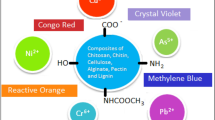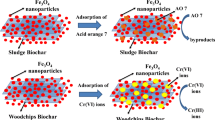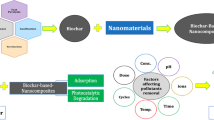Abstract
The current study focuses on synthesizing and characterizing iron oxide-based nanoparticles (D-Fe3O4-NPs) using leave extract of Duranta erecta and iron oxide-chitosan-based nanocomposites (D-Fe3O4-NC). After successfully fabricating D-Fe3O4-NC, it is used for the adsorptive removal of fluoride ions (F−) from water. The characterization study indicated that rough, porous, crystalline, and nanostructure, along with various functional groups of the chitosan, which entrapped the D-Fe3O4-NPs in D-Fe3O4-NC and proved its possibility to be effective adsorbents for the quantitative elimination of F− ions. The batch experimental adsorption study indicated that the quantitative removal of F− was achieved at pH (7), initial concentration of metal ions (10 mg L−1), the content of D-Fe3O4-NC (50 mg), contact time (30 min), and temperature (30 °C). The D-Fe3O4-NC provided 8.82 mM g−1 quantitative F− adsorption capacity. The D-Fe3O4-NC demonstrated a remarkable following the pseudo-second-order kinetics for successfully removing F− through a monolayer adsorption process following the Langmuir isotherms model. The findings of the thermodynamic study revealed that the D-Fe3O4-NC followed the exothermic and spontaneous adsorption process for the adsorption of F−. Furthermore, D-Fe3O4-NC can easily be used several times after washing with diluted HNO3 for the adsorptive removal of F−. Moreover, the F− is quantitatively adsorbed (> 90%) from the collected drinking water samples.






Similar content being viewed by others
Data Availability
I confirm that my no data is available or required from any source.
References
Aigueperse, J., Mollard, P., Devilliers, D., Chemla, M., Faron, R., Romano, R., & Cuer, J. (2000). Ullmann’s Encyclopedia of Industrial Chemistry: Fluorine compounds, inorganic. Wiley-VCH Verlag GmbH & Co.
Akhtar, K., Baig, J. A., Kazi, T. G., Afridi, H. I., Talpur, F. N., Solangi, I. B. & Samaijo, S. J. M. J. (2022). Novel fluoride selective voltammetric sensing method by amino phenylboronic acid-zirconium oxide nanoparticles modified gold electrode. Microchemical Journal, 174, 107073.
Ali, I., ALOthman, Z.A. and Sanagi, M.M. (2015). Green synthesis of iron nano-impregnated adsorbent for fast removal of fluoride from water. Journal of Molecular Liquids, 211, 457–465.
Alqudami, A., Alhemiary, N. A., Munassar, S. J. E. S. & Research, P. (2012). Removal of Pb (II) and Cd (II) ions from water by Fe and Ag nanoparticles prepared using electro-exploding wire technique. Environmental Science and Pollution Research 19, 2832–2841.
Aragaw, T.A. and Ayalew, A.A. (2023). Application of metal-based nanoparticles for metal removal for treatments of wastewater--A review. Emerging Techniques for Treatment of Toxic Metals from Wastewater, 183–231.
Ayyanar, A. and Thatikonda, S. (2021). Enhanced electrokinetic remediation (EKR) for heavy metal‐contaminated sediments focusing on treatment of generated effluents from EKR and recovery of EDTA. Water Environment Research, 93, 136–147.
Baig, J. A., Kazi, T. G., Shah, A. Q., Kandhro, G. A., Afridi, H. I., Khan, S., & Kolachi, N. F. (2010). Biosorption studies on powder of stem of Acacia nilotica: Removal of arsenic from surface water. Journal of Hazardous Materials, 178, 941–948.
Baig, J. A., Kazi, T. G., & Elci, L. (2012). Biosorption characteristics of indigenous plant material for trivalent arsenic removal from groundwater: Equilibrium and kinetic studies. Separation Science and Technology, 47, 1044–1054.
Balan, V., Mihai, C.-T., Cojocaru, F.-D., Uritu, C.-M., Dodi, G., Botezat, D., & Gardikiotis, I. (2019). Vibrational spectroscopy fingerprinting in medicine: From molecular to clinical practice. Materials, 12, 2884.
Bayramoglu, M., Eyvaz, M. and Kobya, M. (2007). Treatment of the textile wastewater by electrocoagulation: Economical evaluation. Chemical Engineering Journal, 128, 155–161.
Bhutto, A. A., Baig, J. A., Kazi, T. G., Sierra-Alvarez, R., Akhtar, K., Perveen, S., Afridi, H. I., Ali, H. E., Hol, A., & Samejo, S. (2023a). Biosynthesis of aluminium oxide nanobiocomposite and its application for the removal of toxic metals from drinking water. Ceramics International, 49, 14615–14623.
Bhutto, A. A., Baig, J. A., SirajuddinKazi, T. G., Sierra-Alvarez, R., Akhtar, K., Hussain, S., Afridi, H. I., Hol, A., & Samejo, S. (2023b). Biosynthesis and analytical characterization of iron oxide nanobiocomposite for in-depth adsorption strategy for the removal of toxic metals from drinking water. Arabian Journal for Science and Engineering, 48, 7411–7424.
Biczak, R., Pawłowska, B., Bałczewski, P. and Rychter, P. (2014). The role of the anion in the toxicity of imidazolium ionic liquids. Journal of hazardous materials, 274, 181–190.
Brahman, K. D., Kazi, T. G., Baig, J. A., Afridi, H. I., Arain, S. S., Saraj, S., Arain, M. B., & Arain, S. A. (2016). Biosorptive removal of inorganic arsenic species and fluoride from aqueous medium by the stem of Tecomella undulate. Chemosphere, 150, 320–328.
Chalitangkoon, J. and Monvisade, P. (2021). Synthesis of chitosan-based polymeric dyes as colorimetric pH-sensing materials: Potential for food and biomedical applications. Carbohydrate Polymers, 260, 117836.
Cruz-Briano, S.A., Medellín-Castillo, N.A., Torres-Dosal, A., Leyva-Ramos, R., Moreno-Piraján, J.C., Giraldo-Gutiérrez, L., Díaz-Flores, P.E., Reyes-López, S.Y. and Ocampo-Pérez, R., & Pollution, S. (2021). Bone char from an invasive aquatic specie as a green adsorbent for fluoride removal in drinking water. Water, Air, & Soil Pollution, 232, 346.
Dave, P.N. and Chopda, L.V. (2014). Application of iron oxide nanomaterials for the removal of heavy metals. Journal of Nanotechnology, 2014.
Dikshit, P. K., Kumar, J., Das, A. K., Sadhu, S., Sharma, S., Singh, S., Gupta, P. K. & Kim, B. S. J. C. (2021). Green synthesis of metallic nanoparticles: Applications and limitations. Catalysts, 11, 902.
Dzieniszewska, A., Nowicki, J., Rzepa, G., Kyziol-Komosinska, J., Semeniuk, I., Kiełkiewicz, D. and Czupioł, J. (2022). Adsorptive removal of fluoride using ionic liquid-functionalized chitosan–Equilibrium and mechanism studies. International Journal of Biological Macromolecules, 210, 483–493.
Ehrampoush, M.H., Miria, M., Salmani, M.H. and Mahvi, A.H. & Engineering. (2015). Cadmium removal from aqueous solution by green synthesis iron oxide nanoparticles with tangerine peel extract. Journal of Environmental Health Science and Engineering, 13, 1–7.
El-Said, G. F., El-Sadaawy, M. M., Aly-Eldeen, M. A. J. E. M., & Assessment. (2018). Adsorption isotherms and kinetic studies for the defluoridation from aqueous solution using eco-friendly raw marine green algae. Ulva Lactuca, 190, 1-15.
Fito, J., Said, H., Feleke, S. & Worku, A. J. E. S. R. (2019). Fluoride removal from aqueous solution onto activated carbon of Catha edulis through the adsorption treatment technology. Environmental Systems Research, 8, 1–10.
Fookes, F.A., Mengatto, L.N., Rigalli, A. and Luna, J.A. & Technology. (2019). Controlled fluoride release for osteoporosis treatment using orally administered chitosan hydrogels. Journal of Drug Delivery Science and Technology, 51, 268–275.
Ghosh, S., Malloum, A., Igwegbe, C. A., Ighalo, J. O., Ahmadi, S., Dehghani, M. H., Othmani, A., Gökkuş, Ö., & Mubarak, N. M. (2022). New generation adsorbents for the removal of fluoride from water and wastewater: A review. Journal of Molecular Liquids, 346, 118257.
Iravani, S. J. G. C. (2011). Green synthesis of metal nanoparticles using plants. Green Chemistry, 13, 2638–2650.
Jadhav, S.V., Bringas, E., Yadav, G.D., Rathod, V.K., Ortiz, I. and Marathe, K.V. (2015). Arsenic and fluoride contaminated groundwaters: A review of current technologies for contaminants removal. Journal of environmental management,162, 306–325.
Kanagasubbulakshmi, S. & Kadirvelu, K. J. D. L. S. J. (2017). Green synthesis of iron oxide nanoparticles using Lagenaria siceraria and evaluation of its antimicrobial activity. Defence Life Science Journal, 2, 422–427.
Karpagavinayagam, P., & Vedhi, C. (2019). Green synthesis of iron oxide nanoparticles using Avicennia marina flower extract. Vacuum, 160, 286–292.
Kazi, T. G., Brahman, K. D., Baig, J. A., & Afridi, H. I. (2018). A new efficient indigenous material for simultaneous removal of fluoride and inorganic arsenic species from groundwater. Journal of Hazardous Materials, 357, 159–167.
Kazi, T. G., Brahman, K. D., Baig, J. A., & Afridi, H. I. (2019). Bioaccumulation of arsenic and fluoride in vegetables from growing media: Health risk assessment among different age groups. Environmental Geochemistry and Health, 41, 1223–1234.
Khan, H. (2021). Assessment of drinking water quality of different areas in Tehsil Isa Khel, Mianwali, Punjab, Pakistan. Pakistan Journal of Analytical & Environmental Chemistry, 22, 376–387.
Leonard, K., Ahmmad, B., Okamura, H., Kurawaki, J. J. C. & Biointerfaces, S. B. (2011). In situ green synthesis of biocompatible ginseng capped gold nanoparticles with remarkable stability. Colloids and Surfaces B: Biointerfaces, 82, 391–396.
Mohammad, A. D. (2020). Appraisal of fluoride contamination in ground water using statistical approach in rural areas of Quetta, Balochistan. Pakistan Journal of Analytical & Environmental Chemistry, 21, 314–321.
Nazari, M. and Halladj, R. (2014). Adsorptive removal of fluoride ions from aqueous solution by using sonochemically synthesized nanomagnesia/alumina adsorbents: an experimental and modeling study. Journal of the Taiwan Institute of Chemical Engineers, 45, 2518–2525.
Pham, X. N., Nguyen, T. P., Pham, T. N., Tran, T. T. N., & Tran, T. V. T. (2016). Synthesis and characterization of chitosan-coated magnetite nanoparticles and their application in curcumin drug delivery. Advances in Natural Sciences: Nanoscience and Nanotechnology, 7, 045010.
Prasad, K. S., Gandhi, P. & Selvaraj, K. J. A. S. S. (2014). Synthesis of green nano iron particles (GnIP) and their application in adsorptive removal of As (III) and As (V) from aqueous solution. Applied Surface Science, 317, 1052–1059.
Pulit-Prociak, J., Stokłosa, K. & Banach, M. J. E. C. L. (2015). Nanosilver products and toxicity. Environmental chemistry letters, 13, 59–68.
Rafique, T., Naseem, S., Usmani, T.H., Bashir, E., Khan, F.A. and Bhanger, M.I.2009, Geochemical factors controlling the occurrence of high fluoride groundwater in the Nagar Parkar area, Sindh, Pakistan. Journal of Hazardous Materials, 171, 424–430.
Rai, P. K., Lee, J., Kailasa, S. K., Kwon, E. E., Tsang, Y. F., Ok, Y. S. & Kim, K.-H. J. E. R. (2018). A critical review of ferrate (VI)-based remediation of soil and groundwater. Environmental research, 160, 420–448.
Riahi, F., Bagherzadeh, M. & Hadizadeh, Z. J. R. A. (2015). Modification of Fe 3 O 4 superparamagnetic nanoparticles with zirconium oxide; preparation, characterization and its application toward fluoride removal. RSC advances, 5, 72058–72068.
Salehi, E., Daraei, P. & Shamsabadi, A. A. J. C. P. (2016). A review on chitosan-based adsorptive membranes. Carbohydrate polymers, 152, 419–432.
Samejo, S., Baig, J. A., Uddin, S., Kazi, T. G., Afridi, H. I., Hol, A., Ali, F. I., Hussain, S., Akhtar, K., Perveen, S., & Bhutto, A. A. (2023). Green synthesis of iron oxide nanobiocomposite for the adsorptive removal of heavy metals from the drinking water. Materials Chemistry and Physics, 303, 127807.
Santhoshkumar, T., Rahuman, A.A., Jayaseelan, C., Rajakumar, G., Marimuthu, S., Kirthi, A.V., Velayutham, K., Thomas, J., Venkatesan, J. and Kim, S.K. (2014). Green synthesis of titanium dioxide nanoparticles using Psidium guajava extract and its antibacterial and antioxidant properties. Asian Pacific journal of tropical medicine, 7, 968–976.
Shar, A. R., Shar, G. Q., Jatoi, W. B., Shar, N. Z., Bhatti, Z., Shar, N. U. H., Jogi, G. M., & Rind, A. H. (2020). Physical and chemical characteristics of drinking water in coastal area of Taluka Keti Bandar, Sindh, Pakistan: a case study. Pakistan Journal of Analytical & Environmental Chemistry, 21, 140–151.
Silveira, C., Shimabuku, Q. L., Fernandes Silva, M. & Bergamasco, R. J. E. T. (2018). Iron-oxide nanoparticles by the green synthesis method using Moringa oleifera leaf extract for fluoride removal. Environmental technology, 39, 2926–2936.
Singh, S., Khare, A. and Chaudhari, S. (2020). Enhanced fluoride removal from drinking water using non-calcined synthetic hydroxyapatite. Journal of Environmental Chemical Engineering, 8, 103704.
Sun, R., Zhang, H.-B., Qu, J., Yao, H., Yao, J. & Yu, Z.-Z. J. C. E. J. (2016). Supercritical carbon dioxide fluid assisted synthesis of hierarchical AlOOH@ reduced graphene oxide hybrids for efficient removal of fluoride ions. Chemical Engineering Journal, 292, 174–182.
Thomas, J. A., Schnell, F., Kaveh-Baghbaderani, Y., Berensmeier, S., & Schwaminger, S. P. (2020). Immunomagnetic separation of microorganisms with iron oxide nanoparticles. Chemosensors, 8, 17.
Vg, V.K. and Prem, A.A. (2018). Green synthesis and characterization of iron oxide nanoparticles using phyllanthus niruri extract. Oriental Journal of Chemistry, 34.
Vijila, B., Gladis, E. E., Jose, J. M. A., Sharmila, T. & Joseph, J. J. M. T. P. (2021). Removal of fluoride with rice husk derived adsorbent from agro waste materials. Materials Today: Proceedings, 45, 2125–2129.
Waghmare, S. S., & Arfin, T. (2015). Fluoride removal from water by various techniques. International Journal of Innovative Studies in Sciences and Engineering Technology, 2, 560–571.
Wang, M., Yu, X., Yang, C., Yang, X., Lin, M., Guan, L. & Ge, M. J. C. E. J. (2017). Removal of fluoride from aqueous solution by Mg-Al-Zr triple-metal composite. Chemical Engineering Journal, 322, 246–253.
Yadav, V. K., Ali, D., Khan, S. H., Gnanamoorthy, G., Choudhary, N., Yadav, K. K., Thai, V. N., Hussain, S. A., & Manhrdas, S. (2020). Synthesis and characterization of amorphous iron oxide nanoparticles by the sonochemical method and their application for the remediation of heavy metals from wastewater. Nanomaterials, 10, 1551.
Yasar, A., Javed, T., Kausar, F., Shamshad, J., Hayat Khan, M. U. & Iqbal, R. J. W. S. (2021). Ground water toxicity due to fluoride contamination in Southwestern Lahore, Punjab, Pakistan. Water Supply, 21, 3126–3140.
Yu, Y., Wang, C., Guo, X., & Chen, J. P. (2015). Modification of carbon derived from Sargassum sp. by lanthanum for enhanced adsorption of fluoride. Journal of Colloid and Interface Science, 441, 113–120.
Zhao, X., Wang, J., Wu, F., Wang, T., Cai, Y., Shi, Y., & Jiang, G. (2010a). Removal of fluoride from aqueous media by Fe3O4@ Al (OH) 3 magnetic nanoparticles. Journal of Hazardous Materials, 173, 102–109.
Zhao, X., Wang, J., Wu, F., Wang, T., Cai, Y., Shi, Y. & Jiang, G. J. J. O. H. M. (2010b). Removal of fluoride from aqueous media by Fe3O4@ Al (OH) 3 magnetic nanoparticles. Journal of Hazardous Materials, 173, 102–109.
Acknowledgements
The National Centre of Excellence in Analytical Chemistry, University of Sindh, Jamshoro, and the High Education Commission (HEC), Islamabad, Pakistan, for project grants under project No. 8147/Sindh/NRPU/R&D/HEC/2017 and partial financial assistance of the current study, respectively, are gratefully acknowledged by all authors. The authors also acknowledged the Young Welfare Society Sindh for helping to gather drinking water samples from various parts of Jamshoro and Hyderabad districts.
Author information
Authors and Affiliations
Corresponding author
Ethics declarations
Conflict of Interest
The authors declare no competing interests.
Additional information
All the authors contributed equally to this manuscript.
Publisher's Note
Springer Nature remains neutral with regard to jurisdictional claims in published maps and institutional affiliations.
Rights and permissions
Springer Nature or its licensor (e.g. a society or other partner) holds exclusive rights to this article under a publishing agreement with the author(s) or other rightsholder(s); author self-archiving of the accepted manuscript version of this article is solely governed by the terms of such publishing agreement and applicable law.
About this article
Cite this article
Samejo, S., Baig, J.A., Kazi, T.G. et al. Iron Oxide-Chitosan-Based Nanocomposite for Efficient Fluoride Removal From Drinking Water. Water Air Soil Pollut 235, 184 (2024). https://doi.org/10.1007/s11270-024-06988-8
Received:
Accepted:
Published:
DOI: https://doi.org/10.1007/s11270-024-06988-8




